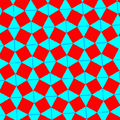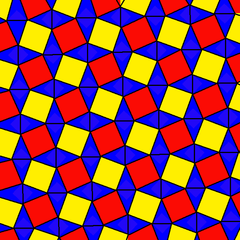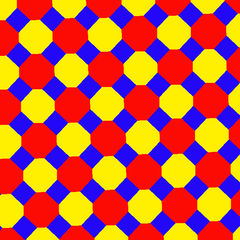
Snub square tiling
Encyclopedia
In geometry
, the snub square tiling is a semiregular tiling of the Euclidean plane. There are three triangles and two squares on each vertex
. It has Schläfli symbol of s{4,4}.
Conway
calls it a snub quadrille, constructed by a snub
operation applied to a square tiling (quadrille).
There are 3 regular and 8 semiregular tilings in the plane.
s of a snub square tiling. (Naming the colors by indices around a vertex (3.3.4.3.4): 11212, 11213.)
which also has 3 triangles and two squares on a vertex, but in a different order.
The snub square tiling can be seen related to this 3-colored square tiling, with the yellow and red squares being twisted rigidly and the blue tiles being distorted into rhombus and then bisected into two triangles.

as a snub
operation from the square tiling, or as an alternate truncation from the truncated square tiling
.
An alternate truncation deletes every other vertex, creating a new triangular faces at the removed vertices, and reduces the original faces to half as many sides. In this case starting with a truncated square tiling with 2 octagons and 1 square
per vertex, the octagon faces into squares, and the square faces degenerate into edges and 2 new triangles appear at the truncated vertices around the original square.
If the original tiling is made of regular faces the new triangles will be isosceles. Starting with octagons which alternate long and short edge lengths will produce a snub tiling with perfect equilateral triangle faces.
Example:
Geometry
Geometry arose as the field of knowledge dealing with spatial relationships. Geometry was one of the two fields of pre-modern mathematics, the other being the study of numbers ....
, the snub square tiling is a semiregular tiling of the Euclidean plane. There are three triangles and two squares on each vertex
Vertex (geometry)
In geometry, a vertex is a special kind of point that describes the corners or intersections of geometric shapes.-Of an angle:...
. It has Schläfli symbol of s{4,4}.
Conway
John Horton Conway
John Horton Conway is a prolific mathematician active in the theory of finite groups, knot theory, number theory, combinatorial game theory and coding theory...
calls it a snub quadrille, constructed by a snub
Snub (geometry)
In geometry, an alternation is an operation on a polyhedron or tiling that removes alternate vertices. Only even-sided polyhedra can be alternated, for example the zonohedra. Every 2n-sided face becomes n-sided...
operation applied to a square tiling (quadrille).
There are 3 regular and 8 semiregular tilings in the plane.
Uniform colorings
There are two distinct uniform coloringUniform coloring
In geometry, a uniform coloring is a property of a uniform figure that is colored to be vertex-transitive...
s of a snub square tiling. (Naming the colors by indices around a vertex (3.3.4.3.4): 11212, 11213.)
| Coloring |  |
 |
|---|---|---|
| Symmetry | 4*2 (p4g) | 442 (p4) |
| Schläfli symbol | h0,1{4,4} | s{4,4} |
| Wythoff symbol Wythoff symbol In geometry, the Wythoff symbol was first used by Coxeter, Longeut-Higgens and Miller in their enumeration of the uniform polyhedra. It represents a construction by way of Wythoff's construction applied to Schwarz triangles.... |
| 4 4 2 | |
| Coxeter-Dynkin diagram Coxeter-Dynkin diagram In geometry, a Coxeter–Dynkin diagram is a graph with numerically labeled edges representing the spatial relations between a collection of mirrors... |
Related tilings
This tiling is related to the elongated triangular tilingElongated triangular tiling
In geometry, the elongated triangular tiling is a semiregular tiling of the Euclidean plane. There are three triangles and two squares on each vertex.Conway calls it a isosnub quadrille....
which also has 3 triangles and two squares on a vertex, but in a different order.
The snub square tiling can be seen related to this 3-colored square tiling, with the yellow and red squares being twisted rigidly and the blue tiles being distorted into rhombus and then bisected into two triangles.

Wythoff construction
The snub square tiling can be constructedWythoff construction
In geometry, a Wythoff construction, named after mathematician Willem Abraham Wythoff, is a method for constructing a uniform polyhedron or plane tiling. It is often referred to as Wythoff's kaleidoscopic construction.- Construction process :...
as a snub
Snub (geometry)
In geometry, an alternation is an operation on a polyhedron or tiling that removes alternate vertices. Only even-sided polyhedra can be alternated, for example the zonohedra. Every 2n-sided face becomes n-sided...
operation from the square tiling, or as an alternate truncation from the truncated square tiling
Truncated square tiling
In geometry, the truncated square tiling is a semiregular tiling of the Euclidean plane. There is one square and two octagons on each vertex. This is the only edge-to-edge tiling by regular convex polygons which contains an octagon...
.
An alternate truncation deletes every other vertex, creating a new triangular faces at the removed vertices, and reduces the original faces to half as many sides. In this case starting with a truncated square tiling with 2 octagons and 1 square
Square (geometry)
In geometry, a square is a regular quadrilateral. This means that it has four equal sides and four equal angles...
per vertex, the octagon faces into squares, and the square faces degenerate into edges and 2 new triangles appear at the truncated vertices around the original square.
If the original tiling is made of regular faces the new triangles will be isosceles. Starting with octagons which alternate long and short edge lengths will produce a snub tiling with perfect equilateral triangle faces.
Example:
 Regular octagons alternately truncated |
(Alternate truncation) |
 Isosceles triangles (Nonuniform tiling) |
 Nonregular octagons alternately truncated |
(Alternate truncation) |
 Equilateral triangles |
See also
- List of uniform planar tilings
- Snub square prismatic honeycombSnub square prismatic honeycombThe snub square prismatic honeycomb is a space-filling tessellation in Euclidean 3-space. It is composed of cubes and triangular prisms in a ratio of 1:2.It is constructed from a Snub square tiling extruded into prisms....
- Tilings of regular polygons

